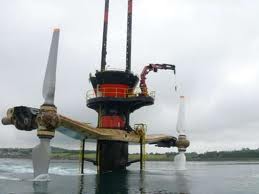
Marine energy has long looked to be a niche area, capable of meeting just a few percent of global power demand. But this seemingly limited energy source is drawing some big players, the latest being Siemens. The German engineering giant boosted its stake this month in Bristol, U.K.-based tidal energy developer Marine Current Turbines from under 10 percent to 45 percent. The attraction, according to Michael Axmann, chief financial officer for Siemens’s solar and hydro division, is the predictability of marine power.
Solar and wind farm operators struggle to predict tomorrow’s output, and bad forecasts can wreak havoc with power transmission planning and market prices. In contrast, the gravitational pull of the moon and sun that controls tidal cycles provides a sure means of anticipating the output from tidal generating stations. “Power output of the systems could be calculated for centuries in advance,” says Axmann.

The result could be higher revenues. Axmann notes that tidal power is “not subject to volatility. This increases the value of the energy produced, and hence makes the business case more reliable for the investor and operator.”
Axmann declined to say how much value would be added by that predictability. But he anticipates that, by 2020, marine turbines will deliver power at a cost that’s competitive with today’s offshore wind farms—in spite of the challenges involved in engineering for underwater operations.
Marine Current Turbines CEO Andrew Tyler says a combination of cost reductions and government incentives will ensure the profitability of his firm’s tidal power parks. He expects a return on investment for the company’s first two offshore power parks: a proposed four-turbine array off Scotland’s Isle of Skye and a five-turbine array off the northwest coast of Wales.
Cost reductions will come in part from scaling up its dual-rotor units to two megawatts from the 1.2 megawatts generated by its demonstration turbine, which has been producing power in Northern Ireland’s Strangford Lough since 2008. Future cost reductions, Tyler says, will come primarily from efficiency in equipment assembly and logistics, drawing on Siemens’s expertise in these areas.
The company also anticipates incentives in the form of U.K. and Scottish installation grants. The tidal power parks will also provide the company with renewable generation credits, which utilities need to acquire to comply with the U.K.’s renewable power standard. Last month, the U.K. announced plans to boost the credits for wave and tidal energy plants from two to five for every megawatt-hour of electricity generated. In comparison, offshore wind farms will earn two credits, and power stations burning biomass will earn one.
Tyler estimates that his first power parks will produce 15,000 to 20,000 megawatt-hours per year, meaning the tidal turbine arrays could earn £3.75 million ($6 million) in incentive payments annually.
Tyler says Siemens’s backing will be crucial to raising the £100 million in private investment needed to finance the projects: “It completely changes their perception about our credibility,” he says.
Paris-based Alstom Group, which competes against Siemens in power equipment and high-speed trains, also expects to make a splash in tidal power next year. Alstom is building a one-megawatt demonstration turbine using technology licensed from Canada’s Clean Current Power Systems. At a meeting in Bali last month, Phillippe Gilson, Alstom’s ocean energy manager, affirmed that Alstom plans to install the 20-meter-tall, fully submersible turbine in Nova Scotia’s Bay of Fundy in 2012.
(Source)

 Follow
Follow